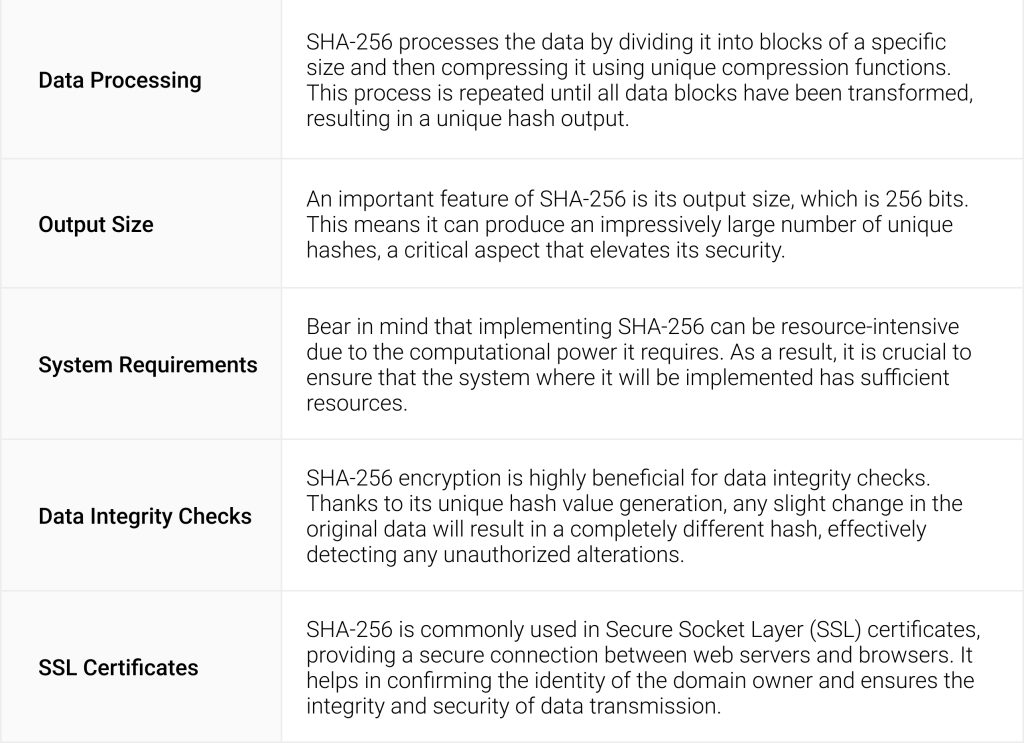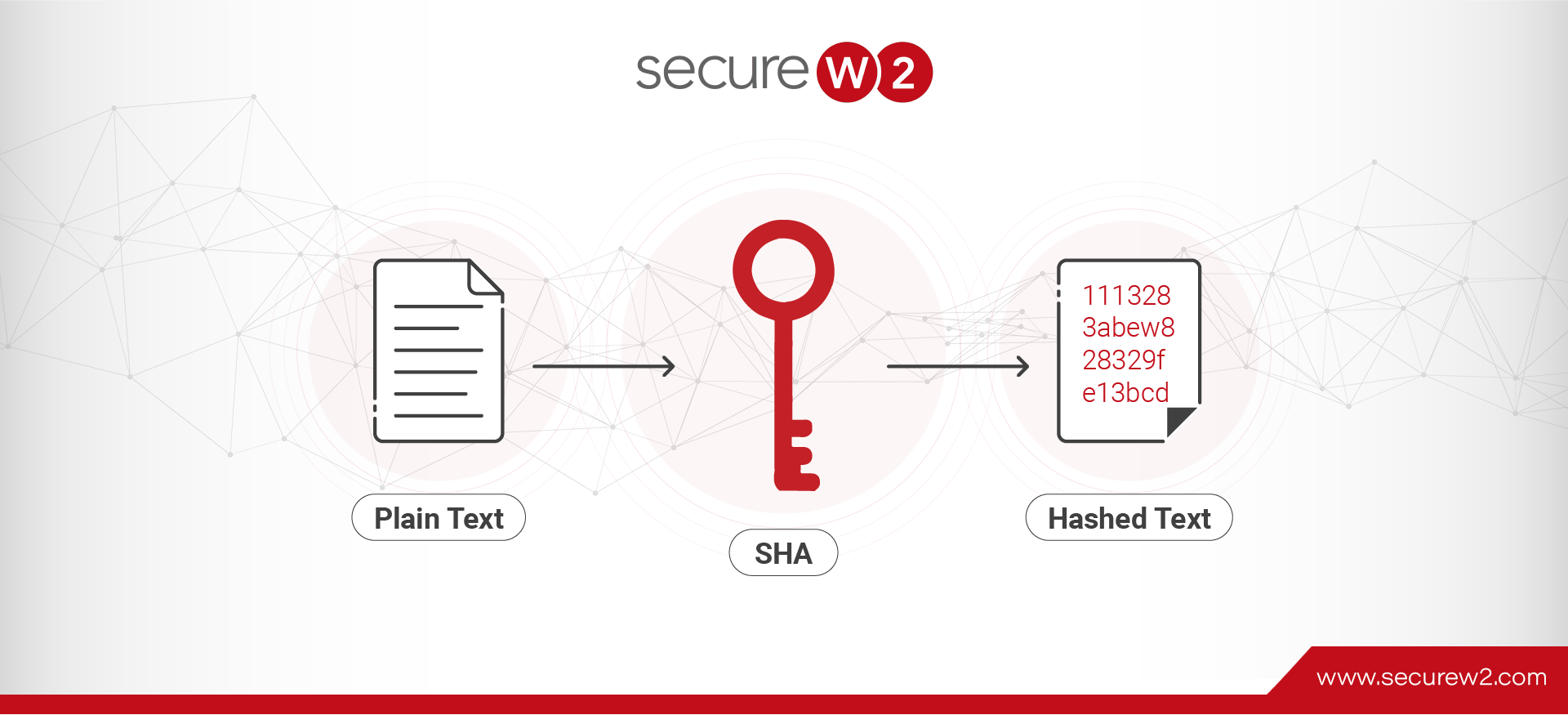Sending information in clear text over the air is a tremendous risk in today’s complex cybersecurity environment. Hackers constantly evolve attack vectors to target sensitive data in transit, but encryption allows us to prevent this.
There are many different encryption algorithms available today, each with strengths and weaknesses. In this blog, we’ll explore SHA encryption, its different iterations, and its applications in certificate-based security.
What is SHA Encryption?
SHA Encryption, or Secure Hash Algorithm, is a renowned hash function often used in cryptographic applications that ensure data security. As a cryptographic hashing algorithm, the primary function is to take an input (or ‘message’) and return a fixed-size string of bytes, typically a hash digest.
SHA encryption transforms the input data into a unique hash value, typically represented in hexadecimal. The resultant hash output is almost impossible to reverse, making it highly secure and a favorite in cryptography.
SHA encryption is more relevant today than ever when data protection and cyber security are highly critical. It helps ensure data integrity, password protection, and the security of sensitive data. It is remarkably used in SSL certificates, ensuring the connection between the web browsers and servers is fully encrypted and secure.
The Power of Cryptographic Hash Functions
Cryptographic hash functions, including SHA-256, are fundamental to data security. They convert input data into a fixed-size hash value, ensuring that even a slight change in the data results in a drastically altered hash value. Cryptographic hash functions are essential for maintaining data integrity and are inseparable from modern cybersecurity strategies.
Types of SHA Encryption
SHA Encryption has multiple types, namely SHA-1, SHA-256, and SHA-512. Each type varies in terms of complexity, security level, and performance.
SHA-1 Encryption
SHA-1 is one of the earliest versions of SHA encryption. The strength of SHA-1 lies in its simplicity and its speed of generating hash algorithms. It transforms the input message into a hash digest of 160 bits. However, its simplicity has also led to its demise due to apparent cryptographic weaknesses.
SHA-256 Encryption
SHA-256, a SHA-2 (Secure Hash Algorithm 2) family member, is a robust and secure hash function compared to SHA-1. It produces a hash value of 256 bits. The double length of the output results in a stronger secure hash function, making it more secure against brute force attacks.
SHA-512 Encryption
SHA-512, another variant of SHA-2, generates a hash digest of 512 bits. It’s considered to be even more secure and complex than SHA-256 but at the expense of speed.
Secure Hash Algorithm
The SHA family is a set of cryptographic hash functions designed by the National Security Agency (NSA). SHA is widely used in cryptographic applications and protocols, including TLS and SSL, PGP, SSH, and IPsec. These algorithms are designed to be one-way functions, meaning they change an input into an output of a specific length that cannot be reversed.
Source: thesslstore.com
Why is SHA Encryption Important?
SHA encryption is used worldwide in various fields and applications. It plays a vital role in digital signatures, SSL certificates, and data protection mechanisms. The computed hash digests are used in checking data integrity and validating the authenticity of transmitted data. Given the rising cyber threats, SHA encryption forms a critical line of defense in cybersecurity. Its unique strength lies in its secure hash functions, making it hard for hackers to crack the encrypted data. This ensures the data stays confidential, thereby preventing data breaches.
SHA encryption is also crucial in maintaining data integrity. It ensures that data has not been changed or modified during transmission. If there’s a slight change in the original data, the hash function would produce a different hash, which makes it excellent for detecting any alterations in the data.
Hash Functions
Hash functions are algorithms that transform an input into a unique output of a certain length. The remarkable factor is that the output size remains constant regardless of the input size. It’s much like scrambling an egg – no matter the size of the egg, the resultant scramble is unique and can’t be reversed back into its original state.
The Relationship Between RSA and SHA
RSA is a widely used encryption methodology that offers secure data exchange through public and private keys. However, RSA alone isn’t sufficient to guarantee data security. SHA encryption comes into play as it verifies the private key holder’s identity, thereby enhancing the RSA-based security systems’ overall reliability and integrity.
The combination of RSA and SHA plays a significant role in providing robust security. RSA provides key generation and encryption, while SHA ensures data integrity and authenticity. Together, they create a more secure environment for exchanging sensitive information online.
SHA-256 vs SHA-1
Regarding SHA-1 and SHA-256, their output hash length, vulnerability to brute force attacks, and overall security are the core differences. SHA-256 is newer and more secure, with a 256-bit hash length as opposed to SHA-1’s 160-bit length. This difference translates directly into a higher level of security for SHA-256.
Security
SHA-1 has known vulnerabilities. With advancements in technology, attacking SHA-1 is no longer computationally expensive. Meanwhile, SHA-256 is considered more secure against collision and brute force attacks, providing a much higher level of security.
Speed and Performance
Though SHA-1 is faster and takes less computational power, it pales compared to the robustness offered by SHA-256. SHA-256, despite requiring more computational resources, provides a more secure hashing algorithm that is increasingly necessary in today’s digital landscape.
Applicability
SHA-256 has seen increased popularity due to its improved security. It is universally used in cryptocurrency mining, digital signatures, and SSL certificates. Despite SHA-1’s speed, its vulnerabilities have led to widespread disapproval by various institutions, urging users to transition to more secure algorithms like SHA-256.
Why SHA-1 is Not Used Anymore
SHA-1 is widely considered obsolete due to its well-documented vulnerabilities. The National Institute of Standards and Technology (NIST) has set its final retirement date to Dec. 31, 2030. Modern computational power can now more readily crack SHA-1’s smaller hash value, making it an unsecured hash function. The industry is now transitioning to more secure hash algorithms like SHA-256 or SHA-3.
SHA-1’s Vulnerabilities
SHA-1 is primarily vulnerable to collision attacks when two different inputs produce the same hash output. This weakens data integrity as a hacker could exploit this flaw, leading to data corruption or unauthorized access.
A collision issue arises in SHA-1 when two input messages produce similar hash data, leading to possible cryptographic hash function manipulation. This vulnerability is a severe security flaw as it can lead to incorrect data validation, compromising the entire system’s security.
Why is SHA-256 So Secure?
SHA-256 is secure due to its 256-bit hash output, making it exponentially more complex and harder to crack than SHA-1. This complexity helps secure against brute force attacks and collision vulnerabilities, making it a more secure hashing algorithm.
Strengths of SHA-256 Encryption
SHA-256 excels in the areas of data integrity, authenticity, and security. Two different inputs can’t yield the same hash output, ensuring high levels of data integrity. Its unique hash values are also ideal for digital certificates, assuring the authenticity of the data and information.
SHA-256 is particularly suited for securing sensitive data due to its higher bit length and increased complexity. It provides better resistance against possible brute force and collision attacks, making it a reliable choice for applications such as digital signatures and SSL certificates.
Weaknesses of SHA-256
While SHA-256’s strengths outweigh its weaknesses, it is crucial to understand that no encryption method is entirely flawless. The main drawback of SHA-256 is its computational demand. It requires significantly more power than SHA-1, which might affect its speed and efficiency when dealing with large volumes of data.
SHA-256’s Irreversibility
SHA-256’s irreversibility is one of its strongest aspects, leading to its resilience against attacks. When a hash is created using SHA-256, it is practically impossible to decipher the original data from the hash output. This one-way function is crucial for properly implementing digital signatures and SSL certificates.
SHA-1 vs SHA-512
SHA-512, another member of the SHA-2 family, is similar to SHA-256 but offers a more extensive 512-bit hash output. This makes SHA-512 remarkably more secure than SHA-1, as the increased bit length significantly decreases the chances of collision attacks.
Strengths and Weaknesses of SHA-512
The prime strength of SHA-512 rests in its high security, thanks to its large block size. Its main weakness, like SHA-256, is its high computational requirements. However, for systems where data security is paramount, the trade-offs for higher computational resources are worthwhile.
SHA-512 typically delivers a slower performance compared to SHA-256. However, regarding security, SHA-512 takes the upper hand with its longer hash output size. Therefore, the choice between SHA-256 and SHA-512 depends on balancing performance needs and security requirements.
Difference between SHA-3 and SHA-512
While SHA-512 is part of the SHA-2 family, SHA-3 is a part of a separate family entirely, despite its sequential naming. SHA-3 is designed to perform well in hardware but is slow in software compared to SHA-2. Unlike SHA-512, which uses a Merkle-Damgård construction, SHA-3 is based on a newer ‘sponge construction’ mechanism, theoretically making it more secure against certain types of cryptanalysis. However, both are deemed secure for general use today.
What Is The Current State of SHA Encryption’s Overall Security?
SHA encryption, notably SHA-2 and SHA-3, continues to enjoy significant confidence in the cybersecurity realm. Despite the computational power required, the robust security it provides makes it the preference for most security-conscious applications and businesses.
Secure Hash Algorithms
Secure Hash Algorithms are a suite of algorithm standards set by the National Institute of Standards and Technology (NIST) that are globally recognized. These include SHA-1, SHA-2, and the latest SHA-3. Each variant has distinct strengths and weaknesses with varying degrees of security and speed. Understanding the differences between these algorithms can help businesses and individuals make informed decisions about their cybersecurity.
While the SHA-2 and SHA-3 variants have proven incredibly secure, it is crucial to remain aware of the evolving security landscape. Future technological advancements, like quantum computing, could pose potential threats to the robustness of SHA encryption. Thus, ongoing research and development are vital to ensuring that SHA encryption continues to serve its purpose effectively.
Implementing SHA-256 for Optimal Security
When implementing SHA-256 for optimal security, it’s crucial to understand the underpinning processes and techniques involved. It’s primarily used in applications and systems where the highest level of security is required despite the added computational requirements. Some key steps and considerations in implementing SHA-256 include:

Leveraging SecureW2’s JoinNow Connector for Enhanced Security
Throughout this article, we’ve explored the importance of robust encryption methods, like SHA-256, in maintaining data integrity and security. A practical application of this is SecureW2’s JoinNow Connector, a Cloud PKI solution designed with these principles in mind. The JoinNow Connector leverages the security strengths of the SHA-256 algorithm to provide strong encryption for network authentication.
SecureW2’s suite of services also includes automatic certificate provisioning for managed devices and self-service onboarding technology for unmanaged devices/BYODs. This results in not just a secure network, but also a streamlined and user-friendly process for network users. This real-world application of SHA-256 encryption demonstrates the critical role of SHA algorithms in cybersecurity solutions. SecureW2 offers affordable data security options for organizations of all shapes and sizes.
Schedule a free demo and get a quote today.



